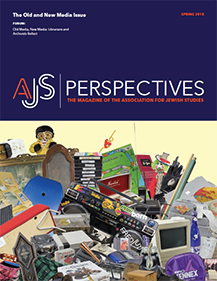Dear Colleagues,
While our age may not be more saturated with media than any other, it may be more self-aware of its media saturation, and more self-absorbed by it. We consume online news, at times obsessively, even as we wonder if we are being manipulated—or monitored—by sinister online organizations. Many of us use social media, and some of us “manage” or even “curate” our social media “presence.” We interact with scholarly materials online—from digitized manuscripts to electronic offprints—as well as with other scholars. We guest lecture in classes using FaceTime and endure the awkwardness of Skype interviews. Even if we don’t tweet, we can’t ignore Twitter; and we increasingly try, with varying levels of success and enthusiasm, to “go paperless,” either for the sake of the earth or the bottom line. We no longer wonder whether “Google” ought to be a verb.
And yet, for all the omnipresence of the digital world, our excitement at receiving an email generally pales beside the rare wonder of receiving a genuine letter. Kindle books cannot (yet!) replace the tactile, at times even olfactory, experience of interacting with a printed volume. And, turning our attention to the Jewish world, we know of no synagogue (yet!) where the Torah is read from a screen. Jewish people, so happy to embrace their identity as “People of the Book” (a title given to Jews, as well as to Christians and Sabians, in the Qur’an), continue to embrace one of the oldest media technologies in the synagogue: the parchment scroll. But those who wish to stream the Torah reading over the Internet are increasingly able to do so. (So far as we are aware, one cannot—yet!—constitute a minyan on Facebook or in Second Life.)
In this issue of AJS Perspectives, we turn our attention directly to the complexities of the media landscapes in which Judaism is lived and by which Judaism and Jewish life are mediated. In part 1, David Stern, Gabriel Levy, Jodi Eichler-Levine, Jeffrey Shandler, and Ben Schachter all address the issue of developments in, and complications of, changes in Jewish media, whether the issue is text or textile, archives or artistry. In part 2, Gary Rendsburg, Itay Marienberg-Milikowsky, and Moshe Yagur and Oded Zinger highlight how scholars who work in antiquity are among those at the forefront of a digital revolution, one in which ancient texts are read anew, and in vastly new ways—although sometimes the innovations are not as radical as they at first may seem. In part 3, Elana Levine and Michael Newman, Laura Arnold Leibman, Ira Wagman, and Rebecca Stein and Adi Kuntsman remind us that new media are not an unalloyed boon. Antisemitism, bias, bigotry, and hate speech—all old sins given new reach, vividness, and durability—color much of the digital mediascape. In these instances, Jews and Judaism are as likely to be an object as a subject.
Recognizing that the relationships among media creators, media creations, and media consumers do not occur in a vacuum, we chose to complement the articles in this issue with a forum that gives a voice to librarians and archivists—those who engage in a range of practical and sophisticated ways with the media, often behind the scenes, with a skill that precisely because of its success goes unnoticed. Digital media has proven so seductive in many ways because it has proven so effortless to use, but a great deal of human ingenuity and experience sustains that user experience.
And so, we invite you to enjoy these reflections on past and present, and in some cases, even the near future. Whether you read this in hard copy or via the online platform, we anticipate that you will find something worth liking (or “liking”) and sharing (or “sharing”)!
Jonathan M. Hess
University of North Carolina at Chapel Hill
Laura S. Lieber
Duke University

